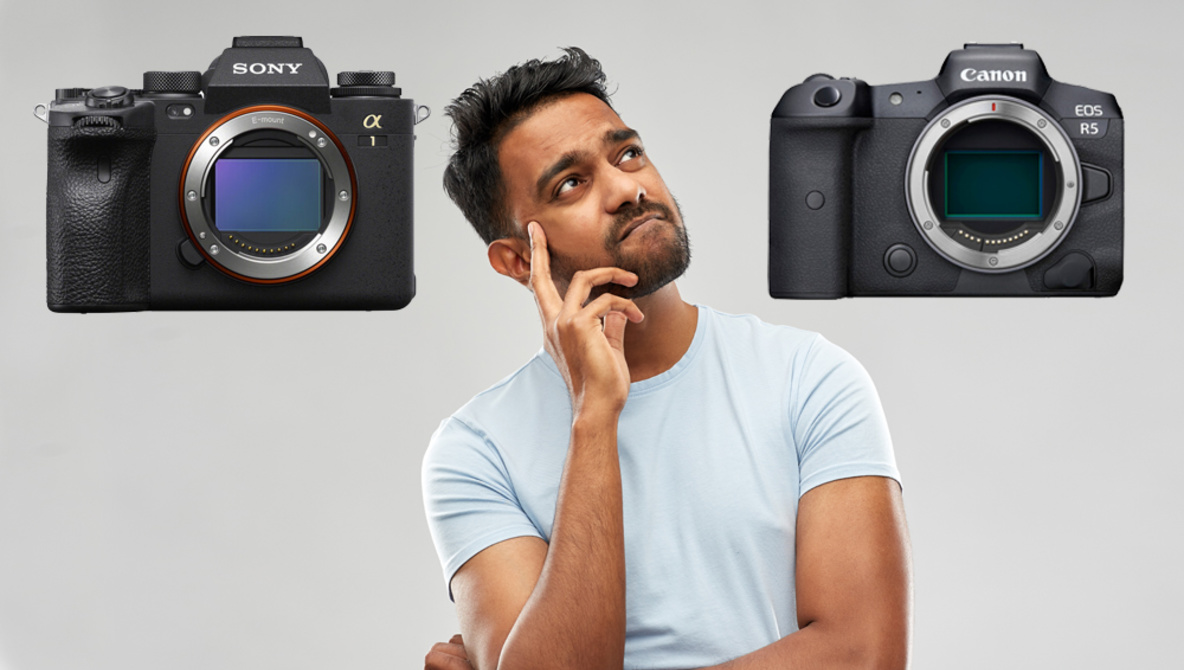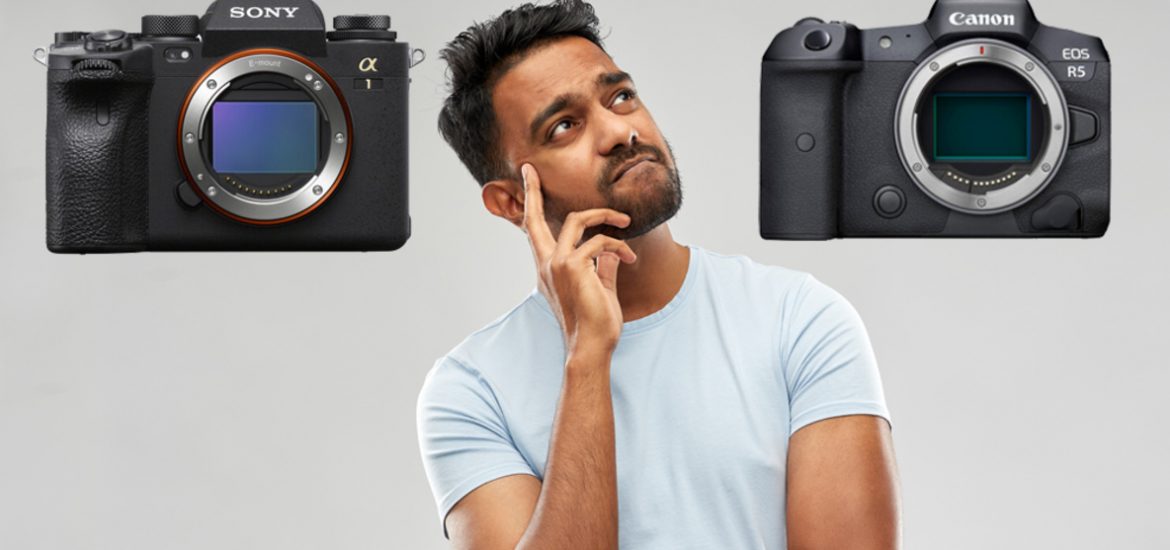
The Sony a1 was just announced, and it is, without question, a remarkable camera. So, why is it good news for Canon?
I, like I’m sure most other people, salivated while reading the Sony a1‘s specs sheet: 50 megapixels, 8K video, 30 fps burst mode, and more. There is no doubt that Sony has blown the doors off the industry with its latest release. So, why is it good for Canon, specifically in reference to the EOS R5? Let’s dive in.
The Sony a1 Is Mostly the Better Camera on Paper
I am certainly not arguing that the specs of the EOS R5 somehow outperform those of the Sony a1. The Sony is either comparable to or outperforms the Canon in pretty much all major aspects. It outpaces it slightly in resolution (50 megapixels to 45 megapixels), and its sensor is backside-illuminated. Its burst rate is 10 fps faster (though the Canon’s mechanical shutter burst rate is 2 fps faster than the Sony) with no viewfinder blackout. More importantly, its sensor readout speed is about 1/240 s, about four times faster than the EOS R5, meaning Sony’s electronic shutter burst mode is far more usable for fast action than the Canon’s, with far less rolling shutter. Its viewfinder has a higher magnification (0.9x to 0.76x), with almost double the resolution of Canon’s and a faster refresh rate. It also offers a higher flash sync speed, doubly fast as the EOS R5.
Canon’s in-body image stabilization does outpace Sony when paired with comparable lenses, at 8 stops to 5.5 stops. The Canon does offer a fully articulating screen, while the Sony’s is fixed. Canon has a top screen, which many pros use, while Sony doesn’t. Both cameras offer 8K video at 30 fps, with the Canon offering internal raw video, albeit with overheating issues. Both offer 4K video at 120 fps.
The Sony offers a pixel-shift mode that outputs a 199-megapixel file. It has built-in Ethernet. It likely edges out the Canon in dynamic range (though Canon has made major strides). Sony claims it offers better heat management, but we’ll see how that pans out in the real world.
Altogether, real-world usage aside, yes, a1 is mostly the better camera when we look purely at the specs.
But Is It Twice as Good?
So yes, the a1 is the (mostly) the technically superior camera. But the a1 is $6,500. The EOS R5 is $3,900. The EOS R5 is 60% the price of the a1. So then, the question becomes: are you willing to spend $2,600 extra for the gains you’ll get? Do you absolutely need 30 fps, or is 20 fps (or 12 fps if you don’t trust the rolling shutter) enough? How about those 5 extra megapixels? A somewhat better viewfinder (the EOS R5’s is already great)? Built-in Ethernet?
For some people, the answer is yes, absolutely. And I’m not writing this to disparage that decision. Perhaps those extra features are indeed worth $2,600 to you. Perhaps you simply need to have a feature the a1 has that the R5 doesn’t, regardless of the price difference. But my point is that Canon has made a camera that is probably 85% the Sony at about half the price.
Sure, we are getting into diminishing returns a bit here, and you can argue that it is reasonable that doubling the price only gets you maybe 15-20% more camera, but the important extra variable here is where the baseline of technology is at the moment. Ten or even only five years ago, there were pros who absolutely needed the jump in specs between the flagship level and the next level down. Nowadays, cameras like the EOS R5 have brought huge technological capabilities down to the second tier, and those capabilities mean that the second tier satisfies the needs of more pros than it did years ago. Sure, there is still a portion of photographers who need (or simply want and are willing to spend for) the absolute best, but the relative proportions have likely changed a bit.
What About Lenses?
And then, we come to lenses. Sony has built out their library quite a bit, for sure. They now have a 400mm f/2.8 and a 600mm f/4, crucial lenses for the type of photographers who are likely to shoot this camera. But there are still some notable absences, such as a 200mm f/2 and 300mm f/2.8.
You might be thinking: “wait, Canon does not have a mirrorless 200mm f/2 or 300mm f/2.8. In fact, they don’t have a mirrorless 400mm f/2.8 or 600mm f/4, but Sony does.” And you would be right. But that actually brings me to my next point: inertia.
What Canon does have is a deep, well-established library of professional quality DSLR lenses, including a 200mm f/2, 300mm f/2.8, 400mm f/2.8, and 600mm f/4, and more importantly, they have a seamless adapter experience that unlike most other adapters, allows for equal (and sometimes even better) autofocus performance and equal image quality. This has allowed the company to explore more esoteric lenses (like the 600mm f/11 and 800mm f/11) in the meantime, as they know that professional users who need such optics already have deep investments in their lenses and are covered by the adapter experience (I recently spoke with one longtime sports photographers who has raved about his experience with the R5 and adapted lenses).
And What About the R1?
One crucially important thing to remember is that the Sony a1 is the company’s flagship camera, meaning it should be compared to Canon’s 1 series of cameras. So far, we have been comparing it to the EOS R5, which is analogous to the company’s 5D series of DSLRs. You can expect the upcoming R1’s capabilities to clearly separate it from the R5, just as the 1D has always been a distinct jump in capabilities from the 5D. And that being said, I expect it to directly compete with (and perhaps surpass in some areas) the Sony a1.
The only variable that’s really in question in regards to the R1’s ability to compete with the a1 is sensor resolution. The a1 departs from traditional flagship design in a major way: sensor resolution. Up until now, flagship sensor resolution has hovered around 18-24 megapixels (The Nikon D6, the Canon 1D X Mark III, and the Sony a9) as photojournalists and sports photographers need speed, not resolution, and given their frequent need to quickly edit and transmit files, additional resolution can actually be a hindrance.
But now, with faster computers and connections and cheaper storage, an argument can be made that keeping the resolution low isn’t as necessary as it once was. Still though, the Nikon D6 and 1D X Mark III follow the older model. Will the R1 continue in that vein, or will it embrace the high-resolution model? Canon has shown they can handle the high-speed pipeline required, with the R5 pumping out 45-megapixel raw files at 20 fps and 8K raw video at 30 fps (essentially 33-megapixel stills). I wouldn’t be surprised to see a significant resolution jump in the R1 over the 1D X Mark III.
Conclusion
The Sony a1 is a spectacular camera, and it is currently enjoying the limelight, which frankly, it deserves. However, it also makes the Canon EOS R5 an even better value by comparison, and given that that camera fills the needs of the vast majority of photographers and that the R1 is waiting in the wings for the few who need more, Canon looks to be in a very good position going forward.
